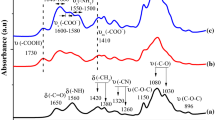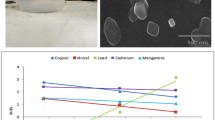Abstract
Emerging contaminants (ECs) have been studied extensively because of the various damages they can cause to the environment, especially due to the non-treated domestic effluents, which contaminate the water bodies. Therefore, it is important to evaluate alternatives to remove these compounds. The objective of this work was to evaluate the potential of a new biosorbent from chitosan modified with vanillin (CTSV) to remove isoniazid, cortisol, bisphenol A, 17α-ethinylestradiol, and triclosan by competitive adsorption studies. Structural characterization of the biosorbents was performed by Fourier transform infrared spectroscopy, thermogravimetry, Brunauer-Emmett-Teller, zeta potential, scanning electron microscopy, and 1H nuclear magnetic resonance. The adsorption for ECs were carried out in an aqueous medium, and quantitative analyzes were performed by HPLC. The effect of pH was evaluated in the pH range 5 to 10 and indicated that better results were found in pH 9 and 8 for CTS and CTSV, respectively. The salt concentrations effect was evaluated in 0.0 to 1.0 mol L−1 and revealed better adsorption conditions in 0.7 mol L−1 of NaCl. The adsorption kinetics pointed to an equilibrium condition reached quickly (with adjustment of data R2 > 0.969) with adequacy to pseudo–second-order model for both biosorbents and ECs. The linear isothermal model was suitable for the adsorption isothermal data and distribution constant (KD) showed the highest values for 17α-ethinylestradiol (0.067 L g−1) and triclosan (0.197 L g−1) in CTSV adsorption. Thus, the results indicated that CTSV performed well in removal for the tested ECs, being an interesting alternative, due to the ease of obtaining and abundance of reagents employed in its preparation.
Graphical abstract




Similar content being viewed by others
References
Akpomie, K. G., & Conradie, J. (2020). Advances in application of cotton-based adsorbents for heavy metals trapping, surface modifications and future perspectives. Ecotoxicology And Environmental Safety. https://doi.org/10.1016/j.ecoenv.2020.110825.
Al-ghouati, M. A., & Da'ana, D. A. (2020). Guidelines for the use and interpretation of adsorption isotherm models: A review. Journal Of Hazardous Materials. https://doi.org/10.1016/j.jhazmat.2020.122383.
Arican, B., Gokcay, C. F., & Yetis, U. (2002). Mechanistics of nickel sorption by activated sludge. Process Biochemistry. https://doi.org/10.1016/S0032-9592(02)00015-8.
Ballesteros, L. F., Teixeira, J. A., & Mussatto, S. I. (2014). Chemical, functional, and structural properties of spent coffee grounds and coffee silverskin. Food And Bioprocess Technology. https://doi.org/10.1007/s11947-014-1349-z.
Basheer, A. A. (2018). New generation nano-adsorbents for the removal of emerging contaminants in water. Journal Of Molecular Liquids. https://doi.org/10.1016/j.molliq.2018.04.021.
Dai, J., He, J., Xie, A., Gao, L., Pan, J., Chen, X., Zhou, Z., Wei, X., & Yan, Y. (2016). Novel pitaya-inspired well-defined core–shell nanospheres with ultrathin surface imprinted nanofilm from magnetic mesoporous nanosilica for highly efficient chloramphenicol removal. Chemical Engineering Journal. https://doi.org/10.1016/j.cej.2015.09.050.
Dehghani, M. H., Ghadermazi, M., Bhatnagar, A., Sadighara, P., Jahed-Khaniki, G., Heibati, B., & Mckay, G. (2016). Adsorptive removal of endocrine disrupting bisphenol A from aqueous solution using chitosan. Journal Of Environmental Chemical Engineering. https://doi.org/10.1016/j.jece.2016.05.011.
Endo, S., Pfennigsdorff, A., & Goss, K. (2012). Salting-out effect in aqueous NaCl solutions: Trends with size and polarity of solute molecules. Environmental Science & Technology. https://doi.org/10.1021/es203183z.
Fomina, M., & Gadd, G. M. (2014). Biosorption: current perspectives on concept, definition and application. Bioresource Technology. https://doi.org/10.1016/j.biortech.2013.12.102.
Freundlich, H. M. F. (1906). Over the adsorption in solution. The Journal of Physical Chemistry, 57, 385–471.
Gautam, R. K., Mudhoo, A., Lofrano, G., & Chattopadhyaya, M. C. (2014). Biomass-derived biosorbents for metal ions sequestration: Adsorbent modification and activation methods and adsorbent regeneration. Journal Of Environmental Chemical Engineering. https://doi.org/10.1016/j.jece.2013.12.019.
Gharaibeh, S. H., Abu-el-sha’r, W. Y., & Al-kofahi, M. M. (1998). Removal of selected heavy metals from aqueous solutions using processed solid residue of olive mill products. Water Research. https://doi.org/10.1016/S0043-1354(97)00221-2.
Haque, A. N. M. A., Remadevi, R., Wang, X., & Naebe, M. (2020). Adsorption of anionic acid blue 25 on chitosan-modified cotton gin trash film. Cellulose. https://doi.org/10.1007/s10570-020-03409-x.
Hindmarsh, P., Geertsma, K., & Hyperplasia, C. A. (2017). A comprehensive guide, Chapter 20, Hydrocortisone (pp. 231–249). Elsevier Academic Press.
Ho, Y. S., & Mckay, G. (1999). Pseudo-second order model for sorption processes. Process Biochemistry. https://doi.org/10.1016/s0032-9592(98)00112-5.
Jiang, L., Gu, Y., Guo, H., Liu, L., & Chen, J. (2017). Efficient removal of 17α-ethinylestradiol (EE2) from water using freshly formed Fe–Mn binary oxide. Royal Society of Chemistry. https://doi.org/10.1039/c7ra02022h.
Joseph, L., Heo, J., Park, Y. G., Flora, J. R. V., & Yoon, Y. (2011). Adsorption of bisphenol A and 17α-ethinyl estradiol on single walled carbon nanotubes from seawater and brackish water. Desalination. https://doi.org/10.1016/j.desal.2011.07.044.
Lagergren, S. S. (1898). About the theory of so-called adsorption of soluble substances Kungliga Suensk Vetenskapsakademiens Handlingar (Vol. 241, pp. 1–39).
Langmuir, I. (1918). The adsorption of gases on plane surfaces of glass, mica and platinum. Journal Of The American Chemical Society. https://doi.org/10.1021/ja02242a004.
Lessa, E. F., Nunes, M. L., & Fajardo, A. R. (2018). Chitosan/waste coffee-grounds composite: an efficient and eco-friendly adsorbent for removal of pharmaceutical contaminants from water. : An efficient and eco-friendly adsorbent for removal of pharmaceutical contaminants from water. Carbohydrate Polymers. https://doi.org/10.1016/j.carbpol.2018.02.018.
Li, H., Wang, P., & Liu, E. W. (2015). Removal of dibutyl phthalate (DBP) from aqueous solution by adsorption using vanillin-modified chitosan beads (CTSV). Journal Desalination and Water Treatment. https://doi.org/10.1080/19443994.2014.938304.
Ligor, M., Kováčová, J., Gadzała-Kopciuch, R. M., Studzińska, S., Bocian, Sz., Lehotay, J., Buszewski, B. (2014). Study of RP HPLC retention behaviours in analysis of carotenoids. Chromatographia, 77(15–16), 1047–1057.
Liu, S., Li, X., Li, T., Liao, L., Cao, L., & Liu, D. (2020). Synthesis of modified chitosan gel beads and adsorption performance of Cu (II). Water, Air, & Soil Pollution. https://doi.org/10.1007/s11270-020-04636-5.
Maksoud, M. I. A. A., Elgarahy, A. M., Farrell, C., Al-Muhtaseb, A. H., Rooney, D. W., & Osman, A. I. (2020). Insight on water remediation application using magnetic nanomaterials and biosorbents. Coordination Chemistry Reviews. https://doi.org/10.1016/j.ccr.2019.213096.
Park, J. M., & Jhung, S. H. (2021). Remarkable adsorbent for removal of bisphenol A and S from water: Porous carbon derived from melamine/polyaniline. Chemosphere. https://doi.org/10.1016/j.chemosphere.2020.129342.
Piyamongkala, K., Mekasut, L., & Pongstabodee, S. (2008). Cutting fluid effluent removal by adsorption on chitosan and sds-modified chitosan. Macromolecular Research. https://doi.org/10.1007/bf03218550.
Poletto, M., Dettenborn, J., Pistor, V., Zeni, M., & Zattera, A. J. (2010). Materials produced from plant biomass: part i. Materials Research. https://doi.org/10.1590/s1516-14392010000300016.
Qian, X., Xu, L., Zhu, Y., Yu, H., & Niu, J. (2020). Removal of aqueous triclosan using TiO2 nanotube arrays reactive membrane by sequential adsorption and electrochemical degradation. Chemical Engineering Journal. https://doi.org/10.1016/j.cej.2020.127615.
Rizzi, V., Lacalamita, D., Gubitosa, J., Fini, P., Petrella, A., Romita, R., Agostiano, A., Gabaldón, J. A., Gorbe, M. I. F., Morte, T. G., & Cosma, P. (2019). Removal of tetracycline from polluted water by chitosan-olive pomace adsorbing films. Science Of The Total Environment. https://doi.org/10.1016/j.scitotenv.2019.133620.
Saheed, I. O., Oh, W. D., & Suah, F. B. M. (2021). Chitosan modifications for adsorption of pollutants – A review. Journal Of Hazardous Materials. https://doi.org/10.1016/j.jhazmat.2020.124889.
Santaeufemia, S., Abalde, J., & Torres, E. (2019). Eco-friendly rapid removal of triclosan from seawater using biomass of a microalgal species: kinetic and equilibrium studies. Journal Of Hazardous Materials. https://doi.org/10.1016/j.jhazmat.2019.02.083.
Shahraki, S., Delarami, H. S., & Khosravi, F. (2019). Synthesis and characterization of an adsorptive Schiff base-chitosan nanocomposite for removal of Pb (II) ion from aqueous media. International Journal Of Biological Macromolecules. https://doi.org/10.1016/j.ijbiomac.2019.07.223.
Sharma, G., Thakur, B., Kumar, A., Naushad, M., Vo, D. V. N., Al-misned, Fahad, A., El-serehy, H. A., & Stadler, F. J. (2020). Ag0-Ag2O embedded nanocomposite hydrogel for adsorption-coupled-photocatalytic removal of triclosan. Materials Letters. https://doi.org/10.1016/j.matlet.2020.128169.
Singh, S., Kumar, V., Datta, S., Dhanjal, D. S., Sharma, K., Samuel, J., & Singh, J. (2020). Current advancement and future prospect of biosorbents for bioremediation. Science Of The Total Environment. https://doi.org/10.1016/j.scitotenv.2019.135895.
Soliman, E. A., El-Kousy, S. M., Abd-Elbary, H. M., & Abou-Zeid, A. R. (2013). Low molecular weight chitosan-based Schiff bases: Synthesis, characterization and antibacterial activity. American Journal Of Food Technology. https://doi.org/10.3923/ajft.2013.17.30.
Sophia, C. A., & Lima, E. C. (2018). Removal of emerging contaminants from the environment by adsorption. Ecotoxicology And Environmental Safety. https://doi.org/10.1016/j.ecoenv.2017.12.026.
Sotelo, J. L., Ovejero, G., Rodríguez, A., Álvarez, A., Galán, J., & García, J. (2014). Competitive adsorption studies of caffeine and diclofenac aqueous solutions by activated carbono. Chemical Engineering Journal. https://doi.org/10.1016/j.cej.2013.11.094.
Starling, M. C. V. M., Amorim, C. C., & Leão, M. M. D. (2018). Occurrence, control and fate of contaminants of emerging concern in environmental compartments in Brazil. Journal of Hazardous Materials. https://doi.org/10.1016/j.jhazmat.2018.04.043.
Tabari, S. A., Esfahani, M. L., Hosseini, S. M., & Rahimi, A. (2019). Neurobehavioral toxicity of triclosan in mice. Food and Chemical Toxicology. https://doi.org/10.1016/j.fct.2019.05.025.
Tan, K. L., & Hameed, B. H. (2017). Insight into the adsorption kinetics models for the removal of contaminants from aqueous solutions. Journal Of The Taiwan Institute Of Chemical Engineers. https://doi.org/10.1016/j.jtice.2017.01.024.
Tonucci, M. C., Gurgel, L. V. A., & Aquino, S. F. (2015). Activated carbons from agricultural byproducts (pine tree and coconut shell), coal, and carbon nanotubes as adsorbents for removal of sulfamethoxazole from spiked aqueous solutions: Kinetic and thermodynamic studies. Industrial Crops and Products. https://doi.org/10.1016/j.indcrop.2015.05.003.
Unuabonah, E. I., Omorogie, M. O., & Oladoja, N. A. (2019). Modeling in adsorption: Fundamentals and applications. Composite Nanoadsorbents. https://doi.org/10.1016/b978-0-12-814132-8.00005-8.
Vilchèze, C., & Jacobs Jr., W. R. (2019). The isoniazid paradigm of killing, resistance, and persistence in mycobacterium tuberculosis. Journal of Molecular Biology. https://doi.org/10.1016/j.jmb.2019.02.016.
Wang, J., & Chen, C. (2014). Chitosan-based biosorbents: Modification and application for biosorption of heavy metals and radionuclides. Bioresource Technology. https://doi.org/10.1016/j.biortech.2013.12.110.
Weber, W. J., Morris, J. C., (1963) Journal of the Sanitary Engineering Division, Vol. 89, Edição 2, Pág. 31-60
Xie, M., Chen, W., Xu, Z., Zheng, S., & Zhu, D. (2014). Adsorption of sulfonamides to demineralized pine wood biochars prepared under different thermochemical conditions. Environmental Pollution. https://doi.org/10.1016/j.envpol.2013.11.022.
Xu, E. G., Chan, S. N., Choi, K. W., Lee, J. H. W., & Leung, K. M. (2018). Tracking major endocrine disruptors in coastal waters using an integrative approach coupling field-based study and hydrodynamic modeling. Environmental Pollution. https://doi.org/10.1016/j.envpol.2017.10.086.
Yang, Z., Miao, H., Rui, Z., & Ji. (2019). Enhanced formaldehyde removal from air using fully biodegradable chitosan grafted β-cyclodextrin adsorbent with weak chemical interaction. Polymers. https://doi.org/10.3390/polym11020276.
Zhou, G. J., Li, X. Y., & Leung, K. M. Y. (2019). Retinoids and oestrogenic endocrine disrupting chemicals in saline sewage treatment plants: Removal efficiencies and ecological risks to marine organisms. Environment International. https://doi.org/10.1016/j.envint.2019.03.030.
Funding
The authors are grateful for the financial and laboratorial support granted by National Council for Scientific and Technological Development — CNPq and INCT-Catálise.
Author information
Authors and Affiliations
Contributions
Carolina dos Santos Cardoso: Methodology, validation, formal analysis, writing — original draft preparation.
Luciano Vitali: Conceptualization, supervision, writing — reviewing and editing.
Corresponding author
Ethics declarations
Conflict of Interest
The authors declare no competing interests.
Additional information
Publisher’s Note
Springer Nature remains neutral with regard to jurisdictional claims in published maps and institutional affiliations.
Highlights
• Chitosan and chitosan-vanillin modified were applied to remove emerging contaminants.
• Chitosan-vanillin modified was obtained through a green synthesis.
• Adsorption studies of emerging contaminants were made in competitive systems.
• The biosorbent chemically modified increased the adsorption efficiency.
• The biosorbent modified has the potential to be applied in wastewater.
Supplementary Information
ESM 1
(DOCX 15353 kb)
Rights and permissions
About this article
Cite this article
dos Santos Cardoso, C., Vitali, L. Chitosan Versus Chitosan-Vanillin Modified: An Evaluation of the Competitive Adsorption of Five Emerging Contaminants. Water Air Soil Pollut 232, 179 (2021). https://doi.org/10.1007/s11270-021-05118-y
Received:
Accepted:
Published:
DOI: https://doi.org/10.1007/s11270-021-05118-y




